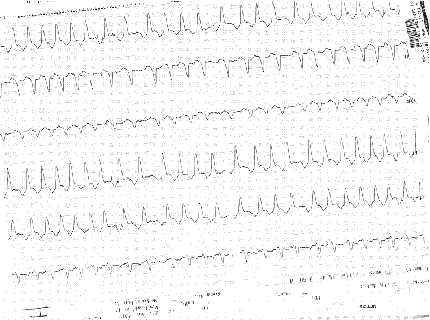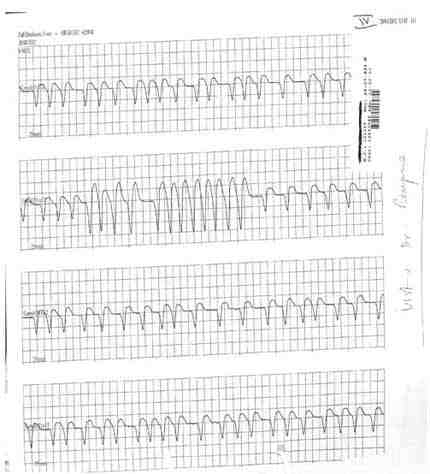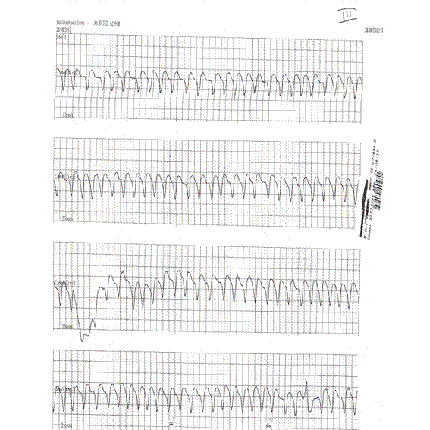Por este motivo se descarta el uso de medidas de soporte vital avanzado y se inicia sedación. El día 31-8-2012 se retira todo el tratamiento diferente a sedación y analgesia. A les 12:55 del mismo días es éxitus.
ECG 1. Fibrilación auricular con respuesta ventricular rápida. BCBDHH + HSA.

ECG 2. Episodio de Taquicardia Ventricular.

ECG 3. Fibrilación ventricular

Diagnóstico:
- Miocardiopatía dilatada de origen isquémico.
- Fibrilación auricular paroxística
- Tirotoxicosis
- Sepsis de origen urinario nosocomial
- Síndrome de fallida multiorgánica.
- Infarto agudo del miocardio
Discusión
El efecto de la disfunción de la glándula tiroides puede conllevar a problemas muy serios, sobretodo si hablamos de un paciente como es el de nuestro caso.
Conclusiones
En este paciente afectado por un hipertiroidismo que alteró de una forma tan importante a la función multiorgánica y conllevó a su muerte, nos hace recapacitar sobre la importancia de realizar pruebas complementarias, como la determinación del nivel de hormonas.
Sin duda alguna, nos fue imposible controlar la frecuencia cardiaca con todos los medios antiarrítmicos: betabloqueantes, digitalis, amiodarona, incluso con la cardioversión eléctrica mejoró su estabilidad hemodinámica, por muy poco tiempo.
El inicio de metimazol en la táctica terapéutica no nos dio el resultado esperado.
El metimazol inhibe la acción de la enzima y tiroperoxidasa de unir el yodo a la tiroglobulina, un paso necesario en la síntesis de tiroxina. La acción ocurre a través del ligando CXCL10, una quimoquina asociada a la membrana celular de las células tiroideas humanas. No suele inhibir la acción del transportador dependiente de sodio ubicado en la membrana basal de las células foliculares. La inhibición de ese paso requiere la inhibición competitiva de perclorato y tiocianato.
El metimazol presentaba las contraindicaciones para utilizar los medicamentos antiarrítmicos que en ese momento utilizábamos, pero se debía intentar.
El tiempo necesario para su efecto serían 3-4 semanas, hecho que no podíamos acelerar el proceso y estabilizar el nivel de hormonas tiroideas y, por supuesto, estabilización clínica y hemodinámica del paciente.
Muchos otros factores como la infección urinaria con desenlace en sepsis, la historia cardiológica (FE 15%), con una miocardiopatía dilatada, dificultó más el pronóstico y aumentó la posibilidad de mortalidad.
Conclusions
In this patient affected by hyperthyroidisme that altered as fast as was posible the multiorganic function, bearing to the death, it makes us reflect on the importance of realizing the determination of extra test as hormona levels.
Undoubtedly, was imposible to control the heart rate with all antiarrhythmics drugs: beta-blockers, digitalis, amiodarona, even with electrical cardioversion we got hemodinamical stability, but no for so long.
The beginning with metimazol during therapeutic tactic dit not give us the expected result.
The methimazol inhibits the action of the enzime and thyroperoxidasa no giving bend to the iodin to thyroglobulin, a necessary step in the thyroxina synthesis. The action occurs through CXCL 10, a kimokina associated to the cell membrane of the human thyroids cells.
Is not usual the inhibition of the independent transport of sodium located at the basis of membrane follicular cells. The inhibition of this step requires the competitive inhibition of perchlorate and thiocianato.
Metimazol presented the contraindications for using the antiarrhythmics drugs we were using in that moment, but was necessary to try it.
The necessary time for effecting should be 3-4 weeks, fact that we could not accelerate the process and stabilize thyroids hormone levels and, of course, clinical and hemodynamical stabilization.
Many other factors as urinal infection with ending in sepsis, cardiologic history (ejection fraction 15%), with a dilated myocardiopathy, it made difficult more the prognosis and increased the mortality chances.
Referencias bibliográficas:
- Dario M. Torre, Geoffrey C. Lamb, Jerome Van Ruiswyk: Kochar’s Clinical Medicine for Students. pp.402-403: Lippincott Williams & Wilkins; Fifth edition (2008) ISBN 0-7817-6699-0″Floyd, J.L. (2009) Thyrotoxicosis. eMedicine».
- Kittisupamongkol W. Hyperthyroidism or thyrotoxicosis? Cleve Clin J Med. Mar 2009;76(3):152.
- Walter Siegenthaler: Differential Diagnosis in Internal Medicine: From Symptom to Diagnosis, p.485: Thieme.
- Occupational thyroid diseaseInt Arch Occup Environ Health. 1992;63(6):373-5. Occupational thyroid disease. DelGuerra P, Caraccio N, Simoncini M, et al
- Janet E. Hall, Lynnette K. Nieman: Handbook of diagnostic endocrinology, pp. 124-125.
- Chan WB, Yeung VT, Chow CC, So WY, Cockram CS. (1999). «Gynaecomastia as a presenting feature of thyrotoxicosis». Postgrad Med J. 882 (75): 229–31.
- Thyrotropin (TSH)-secreting pituitary adenomas.By Roy E Weiss and Samuel Refetoff. Last literature review version 19.1: January 2011. This topic last updated: 2 July 2009
- Eber O, Buchinger W, Lindner W, et al. The effect of D-versus L-propranolol in the treatment of hyperthyroidism. Clin Endocrinol 1990;32:363-72.
- Hertz, Barbara, Schuleller, Kristin, Saul Hertz, MD (1905 – 1950) A Pioneer in the Use of Radioactive Iodine, Endocrine Practice 2010 16,4;713-715.
- Geffner DL, Hershman JM (July 1992). «β-Adrenergic blockade for the treatment of hyperthyroidism». The American Journal of Medicine 93 (1): 61–8.